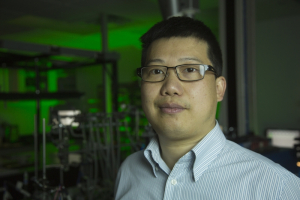Last June, Texas Gov. Rick Perry drove an electric car made by Tesla Motors in front of the Texas State Capitol Building in Austin – a symbolic gesture meant to signify his intention of convincing Tesla executives to build their more than $4 billion battery factory right here in the Lone Star State.
“The timing of all of this couldn’t be better for battery research,” said Yan Yao, assistant professor of electrical and computer engineering at the UH Cullen College of Engineering. Yao recently won a three-year award from the National Science Foundation (NSF) totaling more than $340,000 to study sodium-ion batteries.
This research is particularly important to the state of Texas, which represents one of only four states in the U.S. with an independent electricity grid. Because Texas’ electricity grid operates independently from the national grid, the state has the benefit of making modifications to its grid without seeking federal approval to do so. “Now, the state is looking into adding an energy storage function to the existing grid,” Yao explained. “This is the motivation for my research group.”
Yao’s main research expertise is developing suitable alternatives to traditional lithium-ion batteries, which are used to power much of the modern world. Lithium ions are commonly used in batteries because they are light and have a high energy density, which allows them to hold large amounts of energy in a small space, said Yao.
Lithium, though, is an expensive metal. When building batteries to power a cell phone, for example, the cost of lithium ions may seem somewhat reasonable, but as we move toward building batteries that can power an electric car or store energy from an electricity grid, the need for far cheaper materials becomes increasingly urgent.
That’s why Yao first proposed to study the underlying kinetics and mechanisms of sodium-ion batteries, an earth abundant material that’s much cheaper than lithium-ion. However, Yao explained that sodium-ion batteries are extremely difficult to make. Because the size of sodium ions is much larger than lithium ions, they charge and discharge energy much slower than their lithium counterparts.
Yao said he hopes that by understanding the fundamental limitations of sodium-ion intercalation kinetics in existing host materials used for batteries, his team will be able to develop better sodium-ion batteries which can store and discharge energy as efficiently as lithium-ion batteries.
This research falls under the NSF’s “SusChem” (or sustainable chemistry) initiative, which addresses the interrelated challenges of sustainable supply, engineering, production, and use of chemicals and materials. Yao said much of the research within his lab is devoted to finding low-cost, earth-abundant and sustainable energy storage solutions. All of this work would have an enormous impact in Texas, especially if the state’s bid for Tesla’s so-called gigafactory is successful.
Tesla’s battery factory, which would employ 6,500 workers, will be devoted to research and development for long-range electric batteries. Yao said that many of the non-lithium-ion batteries his lab is developing would work well for electric vehicles and hopefully even for power grid energy storage.
“This is very exciting time,” Yao said. “But to make gigawatt batteries, we first need to figure out how to make batteries as good or better than lithium-ion batteries using earth abundant metals and materials.”
